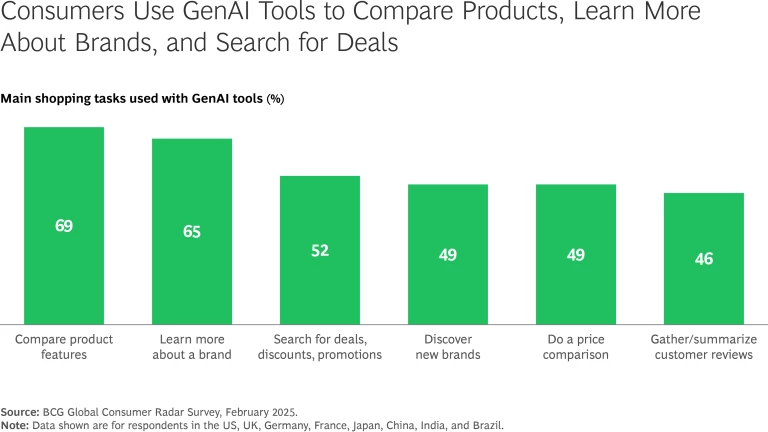The rapid advancements of third-party generative AI (GenAI) tools and agents—and the growing eagerness of consumers to use them for shopping-related tasks—are making brands increasingly dependent on the recommendations they generate. Popular tools such as ChatGPT and Google Gemini now strongly influence a brand’s exposure and customer interactions, because they provide curious customers with conversational answers instead of traditional search results.
The more that these agents affect how customers shop, what they purchase, and how they use what they buy, the more brands risk losing control over the levers that have traditionally shaped their customer experience (CX). Brands that become too dependent on third-party GenAI tools would see a thinner inflow of consumer data, limited options to deliver personalized messages and interactions, and fewer opportunities to capitalize on their expertise. OpenAI intensified this risk in October by creating another sales channel when it launched Instant Checkout, a venture with Etsy and Shopify. That service will enable users of ChatGPT to buy recommended products directly within a conversation.
Providing an effective and differentiated CX starts with meeting customers where they are. When this increasingly occurs in a conversation with an agent powerful enough to deliver instant and accurate recommendations, anticipate needs, and sell products—all without a single customer click—brands need to start capitalizing on the underlying trends instead of resisting them.
We recommend that brands reinvent their CX with a strategic approach built around three complementary “no-regrets” moves: maintaining maximum relevance for third-party agents, launching their own branded agent that plays to their unique strengths and assets, and building workflow tools that make the branded agent and the brand’s human teams more customer-focused and efficient. In today’s fast-changing environment, these actions will help the brand preserve some independence and autonomy.
Stay ahead with BCG insights on marketing and sales
Why the Need to Act Is Urgent
“Wait and see” is no longer an option for brands with respect to AI technologies because the depth and range of tool capabilities and customers’ perceived quality of their output continue to improve. We see three underlying trends that drive the need for brands to take action now and prepare themselves for an environment where every part of the shopping funnel is guided to some extent by customers relying on AI tools:
- Scale that AI tools and agents have achieved to date. ChatGPT’s roughly 700 million users now send an estimated 18 billion messages per week, and 73% of them are unrelated to their work, up from an even split in July 2024, according to a paper co-authored by OpenAI and released in September. The most common forms of personal usage include practical guidance, such as how to use or repair something, and information searches, which are increasingly related to addressing customer missions.
- How customers use AI tools and agents. BCG’s latest Global Consumer Radar Survey showed that 48% of consumers are excited about how GenAI tools can improve the buying experience. Some 22% of GenAI adopters have used the tools to research brands and products to purchase. That includes a wide range of shopping-related tasks, from product comparisons to discovery to price-related searches. (See exhibit.) External studies provide additional findings that corroborate these insights. A 2025 survey of 4,000 shoppers by Omnisend found that over half of shoppers in the US, UK, Canada, and Australia use GenAI tools for shopping tasks at least once per month. The data analytics firm Similaweb, meanwhile, reported that ChatGPT accounted for 20% of Walmart’s referral clicks in August 2025, up from 15% the previous month.
- Future capabilities of AI. We eventually expect the use of AI for shopping to become routine. Customers will use AI agents not only to find what they need, but also to buy it and figure out how to derive the most value from it. This will make the agent ecosystem more complex—and the effects on CX more consequential—as new domain expert and savant agents deliver new kinds of services that span more product categories and collapse traditional customer journeys. This trend is underway in travel planning and financial services, and we expect a plethora of new services that help customers with personal shopping, entertainment, nutritional guidance, and complicated big-ticket purchases such as buying a car.

How Brands Can Capitalize on These Trends: Three No-Regrets Moves
As customers increasingly rely on AI agents for recommendations and eventually for the completion of their various missions, brands can take three steps to reinvent a differentiated and attractive CX that preserves a wide and healthy sphere of influence throughout the buying journey.
- Maximize relevance for third-party agents.
This is a prerequisite for any brand, regardless of the current state of their CX. Brands need to understand how customers are using third-party agents to discover products, how much trust they place in the answers and recommendations, and whether the agent’s ecosystem leads the customer further along their journey. They also need to decode how the third-party agents make their decisions, what information they ingest, and where they source it.
Each agent digests and weighs information differently, which means the brand needs to assess how each algorithm works and how well the brand’s messages and its competitors’ messages fit these channels. Brands should also systematically experiment to make sure their content is both easily digestible and trustworthy.
Customer trust depends on whether a brand’s message appears consistently, accurately, and powerfully, no matter where they encounter it. It also depends on how well the brand provides detailed content and evidence that helps the third-party agents form recommendations. One example of easily digestible trustworthy content is a set of frequently asked questions that are clear, well-structured, and expressed in the language that customers would use to prompt an AI tool.
Brands that regularly assess their current relevance will gain an edge as answer engine optimization (AEO) continues to supersede search engine optimization (SEO). These assessments should be an ongoing, well-monitored process and not a one-off exercise.
- Build your own branded agent.
Many brands will need their own agent to provide recommendations that are even more relevant for customers than what third-party agents provide. Fortunately, the same assets that have historically helped a brand create its traditional CX can help make its own agent attractive: a healthy inflow of first-party data, a strong and authentic brand message that can be tailored or personalized, and the accumulated knowledge and expertise that AI tools and agents cannot replicate.
This expertise is vital, because third-party AI tools and agents function as generalists that cast a wide net in search of information. Strong established brands, however, have a unique depth of specialized expertise that allows them to provide recommendations with a higher level of trust.
By combining that expertise with first-party data and authentic messaging, a brand’s own agent can personalize recommendations to make them even more valuable to customers. The global beauty and cosmetics company L’Oreal, for example, has channeled its expertise in an AI assistant called Beauty Genius, which provides customers with expert analyses as well as personalized product recommendations and care routines.
Done right, these branded agents serve as brand ambassadors that both compete with and complement the third-party agents. The brand needs to ensure that its own agent accurately infers and interprets customer intent and then tailors experiences that reflect the brand.
- Augment human teams with AI workflow tools.
Having real people interact with customers is a powerful differentiator that virtual agents lack. The challenge for brands is to help these teams provide superior service to the customers they interact with directly, whether in a call center, on a shop floor, or in a store.
Many businesses have already tapped into AI and GenAI extensively to support their teams. By transforming their customer service operations, for example, some companies have accelerated workflows and streamlined tasks to make the service experience faster, more flexible, more customer-friendly, and more proactive. Creating a support system of new workflow tools is a natural next step for those companies to augment their teams so that they can resolve customer issues faster, personalize their recommendations, and make decisions more efficiently, thanks to a smaller back end workload.
The deployment of such workflow tools in the luxury sector demonstrates the power of integrating all of a brand’s unique advantages: authentic messaging, the institutional memory built on historical data and unmatched expertise, and the human touch. The workflow tools can enable luxury client advisors to deliver “wow” moments at scale by providing real-time access to client insights, intelligent intuition, and automated proactive prompts. The technologies identify the most promising leads, schedule follow-ups, and prompt the advisor when the client visits in person.
How To Get Started
Customers are becoming increasingly dependent on AI third-party tools and agents to help them with their day-to-day lives, including how they shop. Brands will likewise become more dependent on those tools to reach customers. Authentic trusted brands with a compelling story, a focus on quality, and the ability to generate positive third-party and customer reviews at scale will have an edge in managing their level of dependence on third-party GenAI tools.
The immediate first step is to find the best ways for the third-party agents to work to your brand’s advantage. This means understanding how each one makes its recommendations and ensuring that they can access, ingest, and understand the right information about your brand. Making these assessments and refreshing this content demands a new set of skills from marketers, who will need to balance AEO and SEO.
In parallel, you need to understand what makes your brand unique and assess whether those aspects are powerful enough to offer customers an attractive alternative experience. The more the brand can draw on historical data, strong messaging, and deep expertise to provide better recommendations than a third-party agent can, the more its own branded agent can provide a competitive advantage. In some cases, though, these assets may not have sufficient differentiation, depth, and scale to make such an investment worthwhile.
Finally, you also need to invest in the future roles of your human teams. Workflow tools make them better at their jobs by freeing them from tedious back end tasks and by augmenting their personal interactions with customers. For the foreseeable future, the power of human teams will allow brands to differentiate their CX and preserve some independence from the growing influence of third-party agents.
To support these three efforts, a brand will need a dedicated team that tracks trends in technology, legal frameworks, and other external factors that are shaping future opportunities. They will also need to build a technology backbone that helps them remain flexible in how they collaborate with and integrate third-party agents, their own branded agents, and workflow tools into a superior CX.






